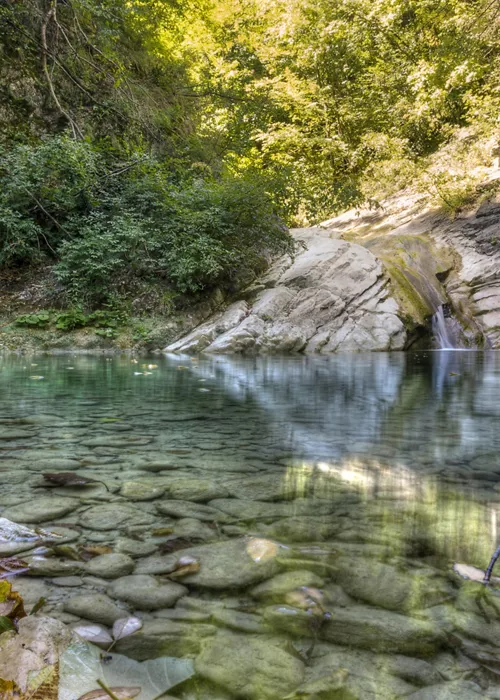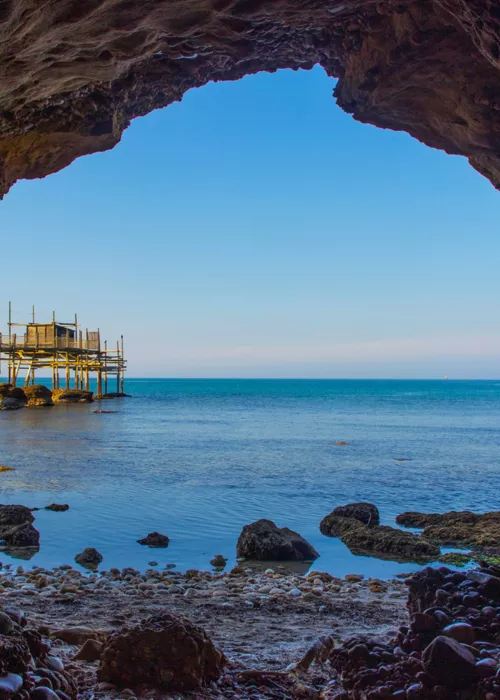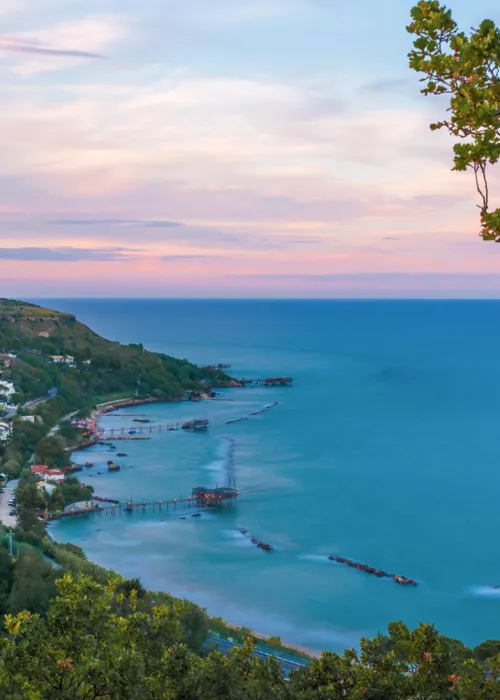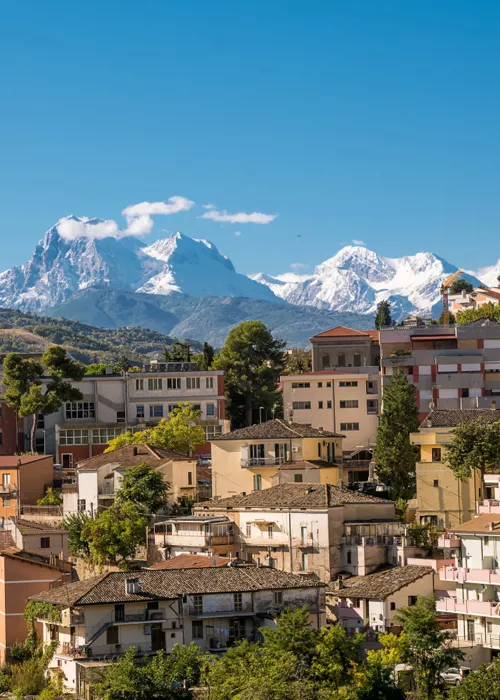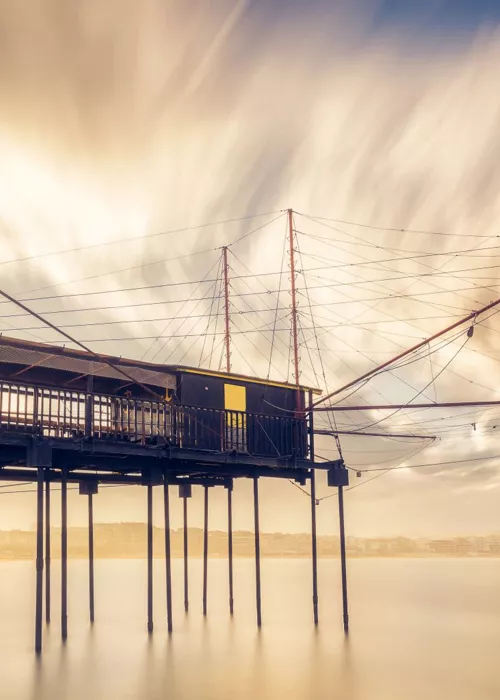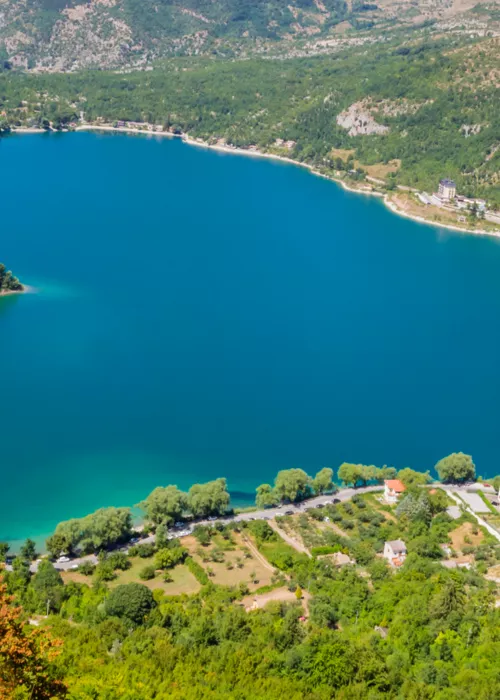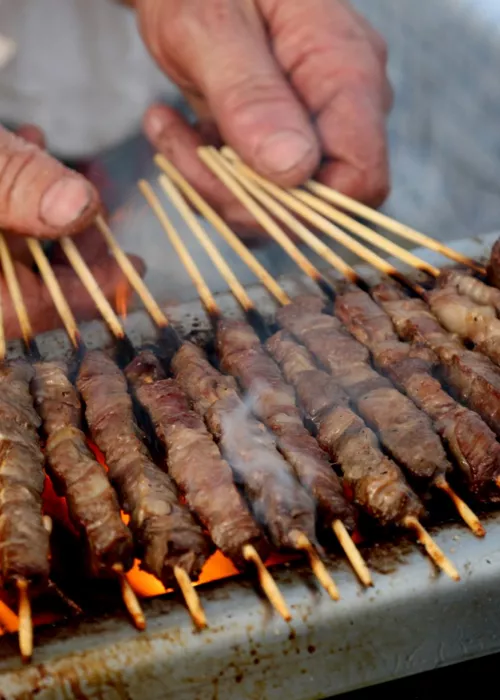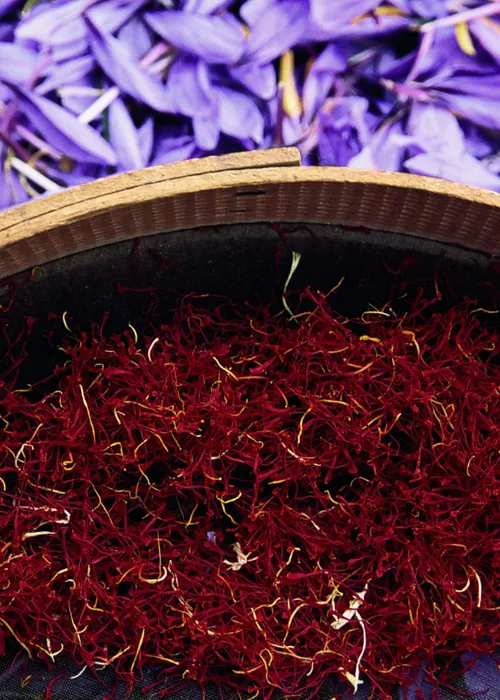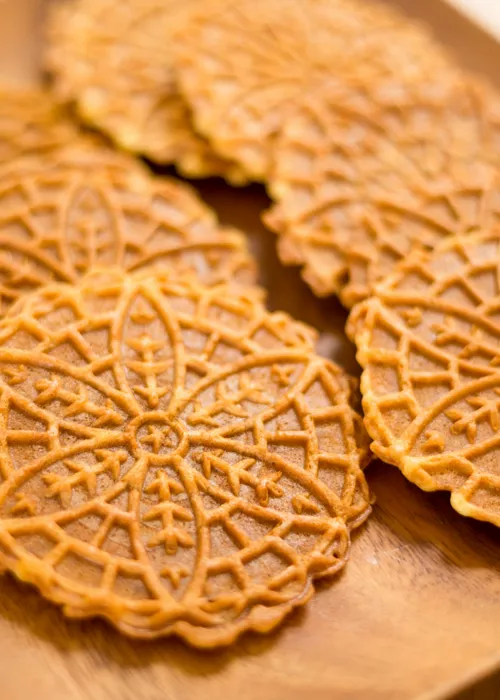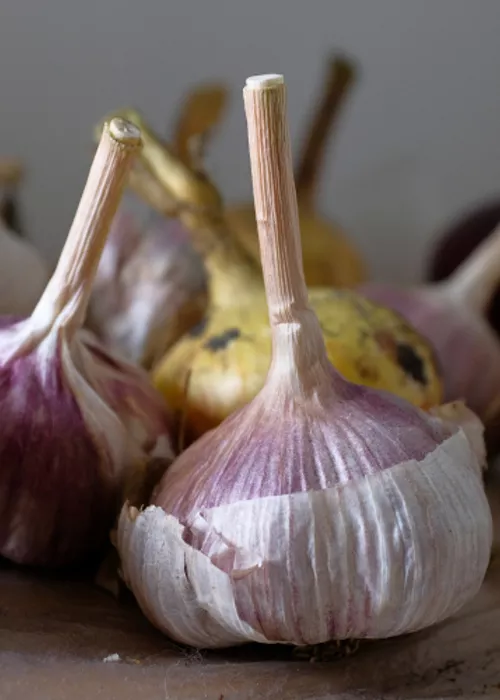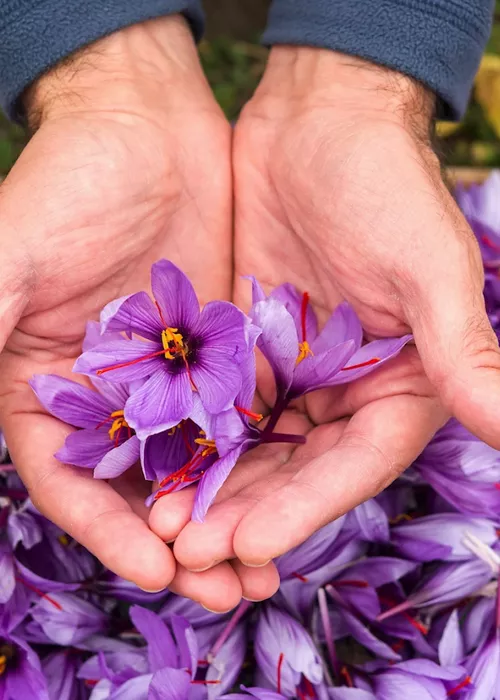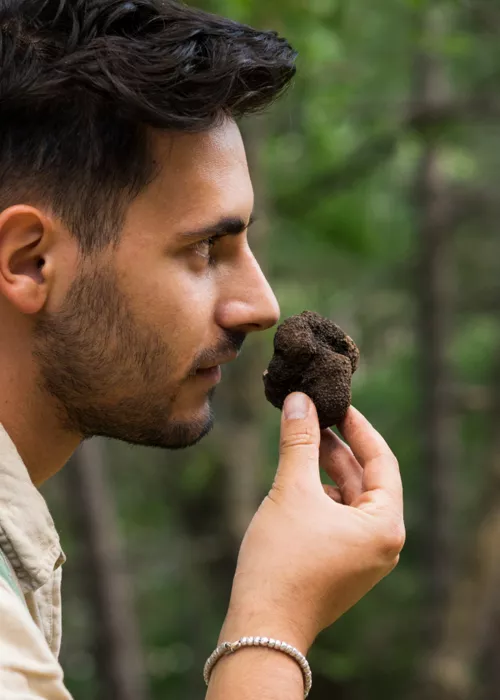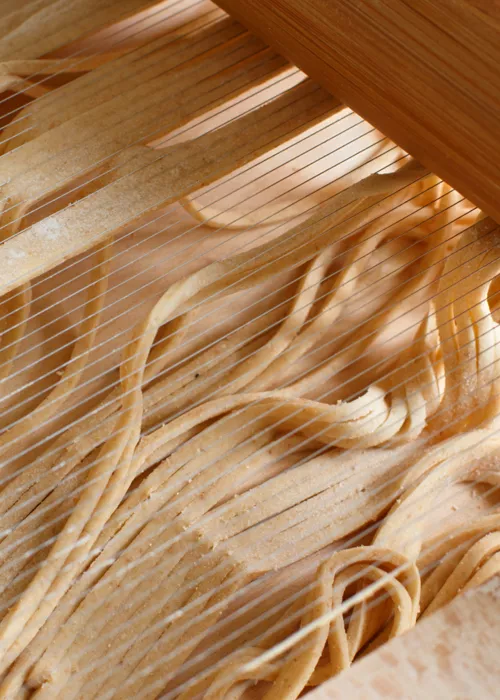Villages to enjoy on Abruzzo’s Trabocchi Coast
8 minutes

South of Pescara, the largest city in Abruzzo, one of the most evocative stretches of the Adriatic coast begins: the 60 km of the Trabocchi Coast. The seemingly delicate wooden constructions on the Adriatic Sea, which D'Annunzio called “colossal spiders”, used by fishermen and today mostly converted into restaurants, are what give it its name and fame. But they are not the only reason to travel there.
San Vito Chietino

Landscapes are always best enjoyed from above, and in San Vito Chietino they know that well. Numerous vantage points offer amazing panoramic views of the Trabocchi Coast, including one spot that’s touted to be the "most beautiful terrace of the Adriatic"!
Top 5 things not to miss:
- The view of the Trabocchi Coast from the Dannunziano Promontory.
- Strolling through the historic centre among narrow streets and colourful houses.
- The view from Belvedere Guglielmo Marconi.
- Enjoying a seafood meal in a trabocco.
- The beach Spiaggia del Turchino in Marina di San Vito.
San Vito Chietino won us over even before we saw its streets and houses. Our first contact with the village was from a viewpoint: Promontorio Dannunziano. Why "Dannunziano"? Because this area, and in particular the yellow house you can see from the viewpoint, the Eremo Dannunziano, was home to the Italian writer and poet Gabriele D'Annunzio, who called the trabocchi "giant spiders”. We confess that the house was not the protagonist of our time at the belvedere. The view of the Adriatic and its trabocchi took all our attention.
Still with the image of the trabocchi etched in our minds, we started the car again and headed for the historic centre of San Vito Chietino, in the upper part of the village. There, among narrow streets, colourful houses rise up, showing us that we were in a seaside village. Flower pots, painted wooden tables and chairs, staircases, churches... All accompanied by a tranquillity that only the sea is capable of transmitting.
At the end of the main street of the historic centre, Corso Trento e Trieste, behind the church of San Francesco, San Vito Chietino overlooks the sea. The Belvedere Guglielmo Marconi is considered by some to be la terrazza più bella dell’Adriatico, the most beautiful terrace of the Adriatic. Besides the sea, you can also see the mountains: the Majella and the Gran Sasso d'Italia. There's no way to get it all in a photo, but we'll take the memory... and a video.
Just over 500 metres separate the belvedere from the marina, the beach. But, as rolling down the hillside was not an option, we had to drive a couple of kilometres to reach the sea. There we parked the car again to continue, parallel to the Adriatic, our tour of San Vito Chietino.
The first thing we wanted to do was to visit a trabocco. We couldn't go to the Costa dei Trabocchi and not visit one. And, since most of them are restaurants, we killed two birds with one stone. There are many options to do so and different cuisines offered by each one. Always from the sea, with fish and seafood, but from the most traditional to the most creative. You decide... we opted for the creative one, those spaghetti cacio e pepe e ricci di mare, with sea urchins, stole our hearts. Even if you don't eat in a trabocco, in Marina di San Vito there are all kinds of seafood restaurants: street food included!
With our bellies full, we took the opportunity to visit the Roman ruins of Murata Bassa by the coast – they didn't have bad taste in choosing where to settle – and, strolling along, we reached the Turchino beach, which takes its name from the blue colour of its waters. A rocky beach where we found the most famous trabocco of the coast, also thanks to D'Annunzio and his work The Triumph of Death: Trabocco Turchino.
Rocca San Giovanni

The historic centre of Rocca San Giovanni is beautiful and its inhabitants know it. They know it and they make the most of it by decorating its alleys and turning them into small open-air ethnographic museums among flower pots. It is the perfect mix that has led Rocca San Giovanni to achieve the seal of Borghi più belli d'Italia, Italy's most beautiful villages.
Top 5 things not to miss:
- Strolling through one of Italy's most beautiful villages.
- Finding the “kiss corner”.
- Learning about traditional fishing at Trabocco Punta Tufano in Vallevò.
- Taking a dip in the Cavalluccio beach or in the Foce beach.
- Cycling or walking along the Via Verde, the “greenway”.
We were unlucky on our visit to Rocca San Giovanni as the colours of the flowers and pots were a little washed out by an overcast day. Despite this, it was clear to us that we were in a special village. Beautiful. Yes. Like many others in Abruzzo. But also "decorated". Metal buckets and pails, gardening tools, washboards and basins, and pans all arranged with exquisite taste. And it's not just one corner of the village, there are many alleyways that look like museum rooms.
The historic centre is very small, we are talking about less than 2,500 inhabitants in the whole village, so we walked through it completely until we reached the remains of its old wall, some sections of which are still preserved. Along the way, we were surprised by a very special sign: L'angolo del bacio. And what is L'angolo del bacio? The “kiss corner”, a place where, according to the sign, “kisses are obligatory”. Obviously, we didn't miss the opportunity.
After eating in a trabocco, we wanted to find out more about the history of these buildings. Where better than in another trabocco? Although the historic centre of Rocca San Giovanni is a little far from the sea, it also has a hamlet by the beach: Vallevò. There, about 10 minutes by car from the centre of Rocca San Giovanni, is the Trabocco Punta Tufano. Its owner told us when the trabocchi were born and how they evolved over time, the laws that protect them, how a trabocco is built and how the net works... A real immersion in the trabocchi culture.

Next to the wooden footbridge that leads to the Trabocco Punta Tufano, passes the Via verde dei Trabocchi, a 42 km cycle path that follows the coastline from Ortona to Vasto. We strolled down to the Spiaggia della Foce to enjoy the sound of the waves. It is a rocky beach, but there are also sandy beaches in this area. A little further along the Via verde dei Trabocchi is a very nice one: Spiaggia del Cavalluccio.
Fossacesia & Torino di Sangro

Fossacesia and Torino di Sangro are located next to each other. Their historic centres were not the reason why we went there. In the vicinity of the Gustav Line in the Second World War, both villages were badly damaged by the fighting. In fact, there is a British military cemetery and, nearby, in Ortona, a Canadian one. But nature, traditions and history convinced us that it was worth the stop.
Top 5 things not to miss:
- The English Cemetery of Torino di Sangro.
- The Lecceta di Torino di Sangro, the only coastal old-growth forest in Abruzzo.
- The abbey of San Giovanni in Venere in Fossacesia.
- Visiting an olive oil mill in Fossacesia.
- An excursion to Roccascalegna.
Our first contact with Fossacesia and Torino di Sangro reminded us of that wartime past in a very explicit way. There are no less than two thousand graves in the Sangro River War Cemetery of soldiers from Britain, India, South Africa and even New Zealand who fell in World War II. A place for reflection, with perfect rows of graves in the midst of a beautiful natural setting.
In this environment there is also a very special forest: the Lecceta Regional Natural Reserve of Torino di Sangro. Why special? Because it is the only primary forest on the coast of Abruzzo. It is not that there are no other forests, which there are, but these were planted by man – almost all of them are pine forests about a century old. The Lecceta is home to native oaks, as well as the largest concentration of tortoises in the region. We enjoyed our walk in the "Jurassic Park" of Abruzzo and saw many oaks, but no tortoises, wolves, wild boar and other wildlife which can be found in the reserve.
We continued our journey up the Adriatic coast to the abbey of San Giovanni in Venere in Fossacesia. The monks of the monastery came to control all the surrounding lands, making San Giovanni in Venere one of the most powerful monasteries in the region during the Middle Ages. This is evident in the decoration of the church, the cloister and the crypt.
The abbey is surrounded by olive trees: this area of Abruzzo is an oil-producing region. We discovered that there are several frantoi, olive oil mills, which produce oil from local olive varieties such as Intosso. Bread with oil is one of the bases of the Mediterranean diet and we were not going to miss the opportunity to learn more about the “liquid gold”... as well as tasting it.
Another village we visited was Roccascalegna. Getting there on the SS652 road seemed easy at first, until we turned off the main road onto a mountain road with many bends and steep slopes. However, the silhouette of the fortress on top of the rock undoubtedly made the drive worthwhile. Its imposing appearance certainly seemed like a film location out of Game of Thrones!
Back in Torino di Sangro, we said goodbye to the Costa dei Trabocchi in the proper way: by the sea. The mouth of the river Sangro and a last beach, spiaggia delle Morge, awaited us. We had planned to see the sunrise a little further south, from Punta Aderci, but the weather was not good enough. We will have to come back, see you soon Costa dei Trabocchi!
Useful Information
Best time to visit. If you're looking to enjoy the beaches of Costa dei Trabocchi, the best time to travel to this part of Abruzzo is summer, better at the beginning and end of summer, when there are fewer tourists. Spring and autumn, with milder temperatures and less tourism, are also a good option, but many restaurants – including the ones in the trabocchi – are closed.
How to get there. The largest city near San Vito Chietino, Rocca San Giovanni, Fossacesia and Torino di Sangro is Pescara – less than 40 km from San Vito Chietino. There is also an international airport there.
Article written about the experience of José A. Álvarez, Salta Conmigo.




